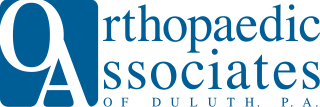What You Need to Know About Tennis Elbow
September 4, 2025
Have you experienced a nagging pain on the outside of your elbow, especially when lifting, gripping or twisting? You might be dealing with tennis elbow. Don’t let the name fool you, you don’t have to be a tennis athlete to get it! Many people develop tennis elbow from everyday work, hobbies or home projects.

At Orthopaedic Associates of Duluth, we see this condition often and know how frustrating it can be. The good news? With the right care, patients recover and get back to living a life in motion quickly.
What Is Tennis Elbow?
Lateral epicondylitis, also called tennis elbow, happens when the tendons that connect your forearm muscles to your elbow get irritated or worn down from overuse. While athletes can get it, so can painters, office workers, gardeners…even parents lifting kids all day!
What Causes Tennis Elbow?
Usually, it comes down to repetition. Doing the same motion over and over puts stress on the tendons until tiny tears develop. Over time, that leads to pain.
Common causes include:
- Repetitive wrist or arm motions (sports, work or hobbies)
- Improper technique in sports like tennis or pickleball
- Heavy lifting without proper support
- Occupational strain from tools, typing or assembly work
Common Symptoms
Tennis elbow pain usually builds up gradually and worsens over weeks and months. This pain may include:
- Achy or sharp pain on the outside of your elbow
- Weak grip (like struggling to open a jar)
- Pain when lifting, shaking hands or twisting your wrist
- Soreness that lingers for weeks
Treatment Options
If pain persists, it is important to see your doctor for their recommendations so the condition does not get worse.
The majority of people get better with non-surgical care options including:
- Rest and avoiding painful activities for a bit
- Ice or anti-inflammatory medication for pain relief
- Braces or straps to take pressure off the elbow
- Physical therapy to stretch and strengthen your arm
- Injections (like corticosteroids or platelet-rich plasma/PRP) if needed
If your elbow pain doesn’t improve after several months of treatment, surgery may be an option. During surgery, the damaged tissue is cleaned up and the healthy tendon is reattached.
Full recovery usually takes a few months and physical therapy helps you regain strength and motion. Our team will work closely with you to make sure your recovery plan fits your lifestyle and goals.
Can You Prevent Tennis Elbow?
You can’t always avoid tennis elbow, but you can lower your risk by:
- Warming up before activities
- Using good form in sports and lifting
- Strengthening your forearm and shoulder muscles
- Taking breaks from repetitive tasks
- Using the right tools for the job (and making sure they’re comfortable)
How is Golfer’s Elbow Different?
Medial epicondylitis, or golfer’s elbow, is a similar condition but affects the inner side of the elbow instead of the outer side. Like tennis elbow, it’s caused by repetitive motions and can affect both athletes and non-athletes. Treatment and prevention strategies are often similar.
When to Reach Out for Help
If your elbow pain hasn’t improved with rest, ice or over-the-counter treatment, has been continuing for more than a few weeks, or is starting to interfere with work, hobbies or daily life – it is time to get expert advice. The earlier you get checked out, the easier it is to treat.
At Orthopaedic Associates of Duluth, our team is here to help you find relief. Give us a call today at (218) 722-5513 or fill out our Contact Form to schedule a visit with one of our specialists.
